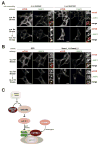The Sestrins interact with GATOR2 to negatively regulate the amino-acid-sensing pathway upstream of mTORC1
- PMID: 25263562
- PMCID: PMC4223866
- DOI: 10.1016/j.celrep.2014.09.014
The Sestrins interact with GATOR2 to negatively regulate the amino-acid-sensing pathway upstream of mTORC1
Abstract
The mechanistic target of rapamycin complex 1 (mTORC1) kinase is a major regulator of cell growth that responds to numerous environmental cues. A key input is amino acids, which act through the heterodimeric Rag GTPases (RagA or RagB bound to RagC or RagD) in order to promote the translocation of mTORC1 to the lysosomal surface, its site of activation. GATOR2 is a complex of unknown function that positively regulates mTORC1 signaling by acting upstream of or in parallel to GATOR1, which is a GTPase-activating protein (GAP) for RagA or RagB and an inhibitor of the amino-acid-sensing pathway. Here, we find that the Sestrins, a family of poorly understood growth regulators (Sestrin1-Sestrin3), interact with GATOR2 in an amino-acid-sensitive fashion. Sestrin2-mediated inhibition of mTORC1 signaling requires GATOR1 and the Rag GTPases, and the Sestrins regulate the localization of mTORC1 in response to amino acids. Thus, we identify the Sestrins as GATOR2-interacting proteins that regulate the amino-acid-sensing branch of the mTORC1 pathway.
Copyright © 2014 The Authors. Published by Elsevier Inc. All rights reserved.
Figures




References
-
- Boussif O, Lezoualc’h F, Zanta MA, Mergny MD, Scherman D, Demeneix B, Behr JP. A versatile vector for gene and oligonucleotide transfer into cells in culture and in vivo: polyethylenimine. Proceedings of the National Academy of Sciences of the United States of America. 1995;92:7297–7301. - PMC - PubMed
Publication types
MeSH terms
Substances
Grants and funding
LinkOut - more resources
Full Text Sources
Other Literature Sources
Molecular Biology Databases
Research Materials
Miscellaneous

